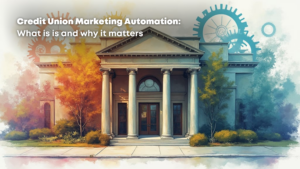Getting a new fintech off the ground can feel like a herculean task. It takes a coordinated effort between developers, marketers, and sales to start bringing in clients. But without that effort, there’s little chance for success.
The fact is, great products don’t sell themselves. Your fintech’s target market probably hasn’t heard of your company or your solution. And if they haven’t heard of you, how can they buy from you?
Here’s how to get your brand and your product in front of eligible prospects. It’s a process we call Fintech Launch:
How to Launch a Fintech
Before getting into the steps, we should note two caveats. First, this is a simplified version of the CU 2.0 Fintech Launch process. Second, this covers digital marketing outreach only—it doesn’t include other influencer work, PR, or the creation of key marketing collateral like blogs, case studies, lead magnets, or videos.
1. Determine your target audience
There’s no point in marketing your solution to an audience that can’t use it. Focus your efforts exclusively on the people who will benefit from your product. (This step is the same as building a target persona for marketing.)
Once you identify your audience, remember to keep your messaging specific to them. No need to tout benefits or features that don’t make their lives easier. No reason to bring in jargon that your audience doesn’t use in their daily operations. Concern yourself only with learning their pain points and how you can address them.
2. Find contacts in your target audience
After you know what your audience looks like, it’s time to know who they are… exactly. Find the contact information for people that fit your target persona and build an email list. With this list, you’ll be able to begin launching your campaign.
This step is not an easy one. There are some tools, services, and agencies that can accomplish this for you. Often, building this list is time-, labor-, and/or money-intensive. However, although working without a list can be simpler, it’s also far less effective and can rack up a hefty monthly tab for ad spend.
3. Create an email marketing sequence
There are several ways to build an effective email marketing sequence. But there are two big questions you must ask:
First, are you pushing for awareness or conversion? The ultimate goal is to sell, of course, and both types of campaigns will get you there. You can read more about this question here.
Second, are you marketing from brand to brand or from person to person? If you’re marketing as a brand, your email will need branding, some design elements, and a clear CTA that leads to your website. If you’re marketing from person to person, your email campaign may be less formal, and your goal will be to get a reply to start a conversation.
Either way, assume that you’ll need a minimum of three emails in either campaign. Many good email sequences last more than a month and include 7–10 messages in total!
4. Send the email sequence to your list
One thing to consider is to segment your list and send the sequence to a new segment every week or two. This allows your team to tweak the email subject lines, messages, CTAs, or cadence as you go.
Nobody opened up email #2? Change the subject line!
Email #4 had a high open rate but low click-through? Change the CTA!
This rolling cadence can be particularly effective when combined with an SEO / inbound marketing strategy by keeping traffic coming to the content you want to rank for.
5. Explore retargeting strategies
Cold email marketing has an exceptionally low conversion rate, especially in B2B scenarios. That’s fine!
A lot of the value in the early stages of a fintech launch is simply in getting your brand out there. The next time your target audience sees something from your brand, they’ll be more familiar with it—and more trusting.
Many of your audience will open your emails. Some will click through. Even if they don’t convert at first, these are viable leads. Including a retargeting pixel in your email, landing pages, or CTA content will set you up for future marketing and brand reinforcement.
Tracking and displaying ads to the leads who engaged with your first email campaign can lead to much higher engagement and conversion in future email and display ad campaigns.
6. Second email sequence
After sending a “warm up” email sequence and building a retargeting list, it’s time to rinse and repeat. Except this time, your audience has seen emails from you already. They’ve seen display ads that further introduce your brand and its solution.
The final step in launching your fintech is sending a second email sequence to your most engaged leads.
This sequence can be much more sales-forward. Instead of introducing your brand and what your solution does, you can move right into discussing how your solution will solve their problem or make their life easier.
Get Help Launching Your Fintech
If you’d like to get your brand (and your solution) in front of thousands of new prospects, an agency is your best bet. Agencies like CU 2.0 have helped dozens of other fintechs get a foothold in many target industries.
See our Lead Generation & Fintech Launch service here.
To learn more about fintech marketing, subscribe to our blog or follow the links below!
How to Launch a Fintech Startup
What Credit Union Marketing Automation Is and Why It Matters




